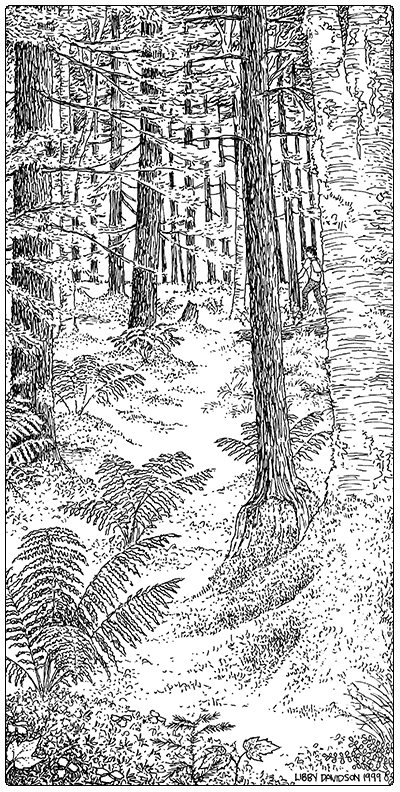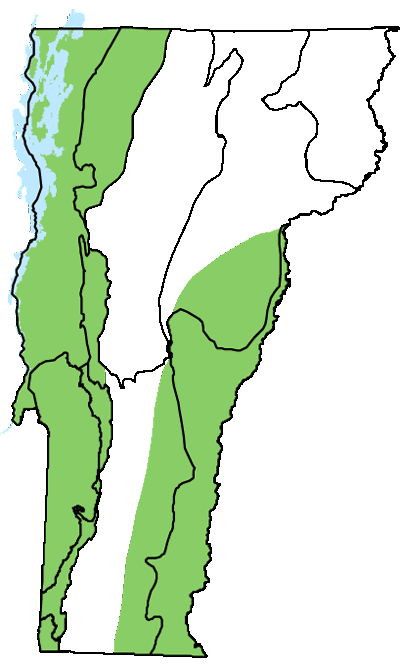Ecology and Physical Setting
Found in small bedrock pockets, these green, spongy swamps create a sharp contrast to the typically dry, rocky upland forests that surround them. Cold air drainage, peat that traps cold into the growing season, cooling from evapotranspiration, and a coniferous canopy make these places significantly cooler than the surrounding forests. Hemlock-Sphagnum Basin Swamps usually occur at elevations under 1,500 feet and are found in the warmer regions of Vermont.
Hemlock-Sphagnum Basin Swamps have dense hemlock canopies, deep peat, sphagnum-dominated hummocks and hollows, and little surface water. Most are smaller than 10 acres and many are less than one acre. These and other basin swamps have small surface watersheds. Because of these small watersheds and basin settings, most Hemlock-Sphagnum Basin Swamps do not have inlet streams, and many do not have outlet streams. The retention of water in these basins has led to the accumulation of deep organic soils over the thousands of years since the last glaciation. These peats can be 16 feet or more in depth, and are made up of poorly-decomposed sphagnum and wood fragments. These swamps do not receive any substantial input of groundwater discharge or seepage. This, along with their distribution over mostly acidic bedrock, results in mineral-poor waters, acid-tolerant species, and a lack of seepage indicators.
Vegetation
The canopy of these swamps is typically closed, creating a shady swamp floor, but some examples have more open woodland canopies. Hemlock is dominant. Other canopy trees varying in their abundance include red maple, yellow birch, red spruce, and white pine. The shrub layer is sparse; it includes tall shrubs such as winterberry holly, mountain holly, highbush blueberry, and wild raisin. Hemlock seedlings and saplings take root on rotting nurse logs. Low sweet blueberry and creeping snowberry are occasional on hummocks. Shrubs are more abundant in swamps that have a greater proportion of deciduous trees in the canopy.
Cinnamon fern forms dense stands on the hummocks. Three-seeded sedge is common. Boreal herbs, including goldthread, bluebead lily, starflower, twinflower, and Canada mayflower, are scattered across the mossy hummocks and hollows. Other herbs include northern bugleweed, sarsaparilla, and partridgeberry. The bryophyte cover ranges from 50 to 90 percent and is strongly dominated by sphagnum mosses, primarily Sphagnum girgensohnii and Sphagnum centrale. Other bryophytes include stair-step moss, pincushion moss, and three-lobed bazzania. Hemlock-Sphagnum Basin Swamps have low species richness compared to seepage swamps.
Wildlife Habitat
The dense evergreen canopy of Hemlock-Sphagnum Basin Swamps provides winter cover for white-tailed deer. The hemlock canopy also provides nesting habitat for several species of birds, including northern waterthrush, Canada warbler, northern parula, and northern saw-whet owl. Winter wrens use tree tip-ups for nesting. The saturated sphagnum swamp floor is ideal habitat for four-toed salamanders.
Related Communities
- Red Maple-Sphagnum Basin Swamp has a canopy dominated by red maple, with hemlock absent or a minor component. Shrubs and herbs are similar in composition but greater in cover. Sphagnum dominates the swamp floor.
- Hemlock-Balsam Fir-Black Ash Seepage Swamp has hemlock and/or balsam fir sharing the canopy with black ash. Species richness is much higher and there are many species indicative of groundwater seepage. Outlet streams are present.
- Red Spruce-Cinnamon Fern Swamp is a cooler climate swamp dominated by red spruce, with red maple and balsam fir common in the canopy. A well-developed tall shrub layer of mountain holly and wild raisin is typical. Cinnamon fern and sphagnum are abundant, and there are usually some species indicative of mineral enrichment.
Conservation Status and Management Considerations
This is a rare natural community type in Vermont, with the combined total area of all the known examples occupying less than 100 acres. To maintain their natural dynamics, it is recommended that no timber harvesting take place in these swamps. If there is harvesting within the small watershed, it should be minimal, and should be carefully planned to avoid hydrologic alteration. Many known examples have old trees and have had little timber harvesting in their history, presumably due to the poor-quality timber growing in the saturated, acidic soils. Development should be excluded from the small watersheds.
Distribution/Abundance
This is a rare natural community, occurring at elevations below 1,500 feet in warmer regions of the state. Similar swamps can be found across the region, from New Brunswick to Pennsylvania.
Characteristic Plants
Trees
Abundant Species
Eastern hemlock – Tsuga canadensis
Occasional to Locally Abundant Species
Red maple – Acer rubrum
Yellow birch – Betula alleghaniensis
Red spruce – Picea rubens
White pine – Pinus strobus
Shrubs
Winterberry holly – Ilex verticillata
Mountain holly – Ilex mucronata
Highbush blueberry – Vaccinium corymbosum
Wild raisin – Viburnum nudum var. cassinoides
Low sweet blueberry – Vaccinium angustifolium
Herbs
Abundant Species
Cinnamon fern – Osmundastrum cinnamomeum
Three-seeded sedge – Carex trisperma
Occasional to Locally Abundant Species
Goldthread – Coptis trifolia
Creeping snowberry – Gaultheria hispidula
Bluebead lily – Clintonia borealis
Starflower – Lysimachia borealis
Canada mayflower – Maianthemum canadense
Twinflower – Linnaea borealis
Northern bugleweed – Lycopus uniflorus
Sarsaparilla – Aralia nudicaulis
Partridgeberry – Mitchella repens
Swamp dewberry – Rubus hispidus
Bryophytes
Moss – Sphagnum girgensohnii
Moss – Sphagnum centrale
Moss – Sphagnum magellanicum
Stair-step moss – Hylocomium splendens
Pincushion moss – Leucobryum glaucum
Three-lobed bazzania – Bazzania trilobata
Rare and Uncommon Plants
Barbed-bristle bulrush – Scirpus ancistrochaetus
Sharp mannagrass – Glyceria acutiflora
Floating mannagrass – Glyceria septentrionalis
Massachusetts fern – Parathelypteris simulata
Virginia chain fern – Woodwardia virginica
Lily-leaved twayblade – Liparis liliifolia
Loesel’s twayblade – Liparis loeselii
Associated Animals
Porcupine – Erethizon dorsatum
White-tailed deer – Odocoileus virginianus
Winter wren – Troglodytes hiemalis
Northern waterthrush – Parkesia noveboracensis
Canada warbler – Cardellina canadensis
Northern parula – Parula americana
Rare and Uncommon Animals
Four-toed salamander – Hemidactylium scutatum
Blue-spotted salamander – Ambystoma laterale
Northern saw-whet owl – Aegolius acadicus
Places to Visit
Snake Mountain Wildlife Management Area, Addison, Vermont Fish and Wildlife Department (VFWD)
Pond Woods Wildlife Management Area, Benson and Orwell, VFWD
High Pond Natural Area, Pittsford, The Nature Conservancy
Skitchewaug Wildlife Management Area, Springfield, VFWD
